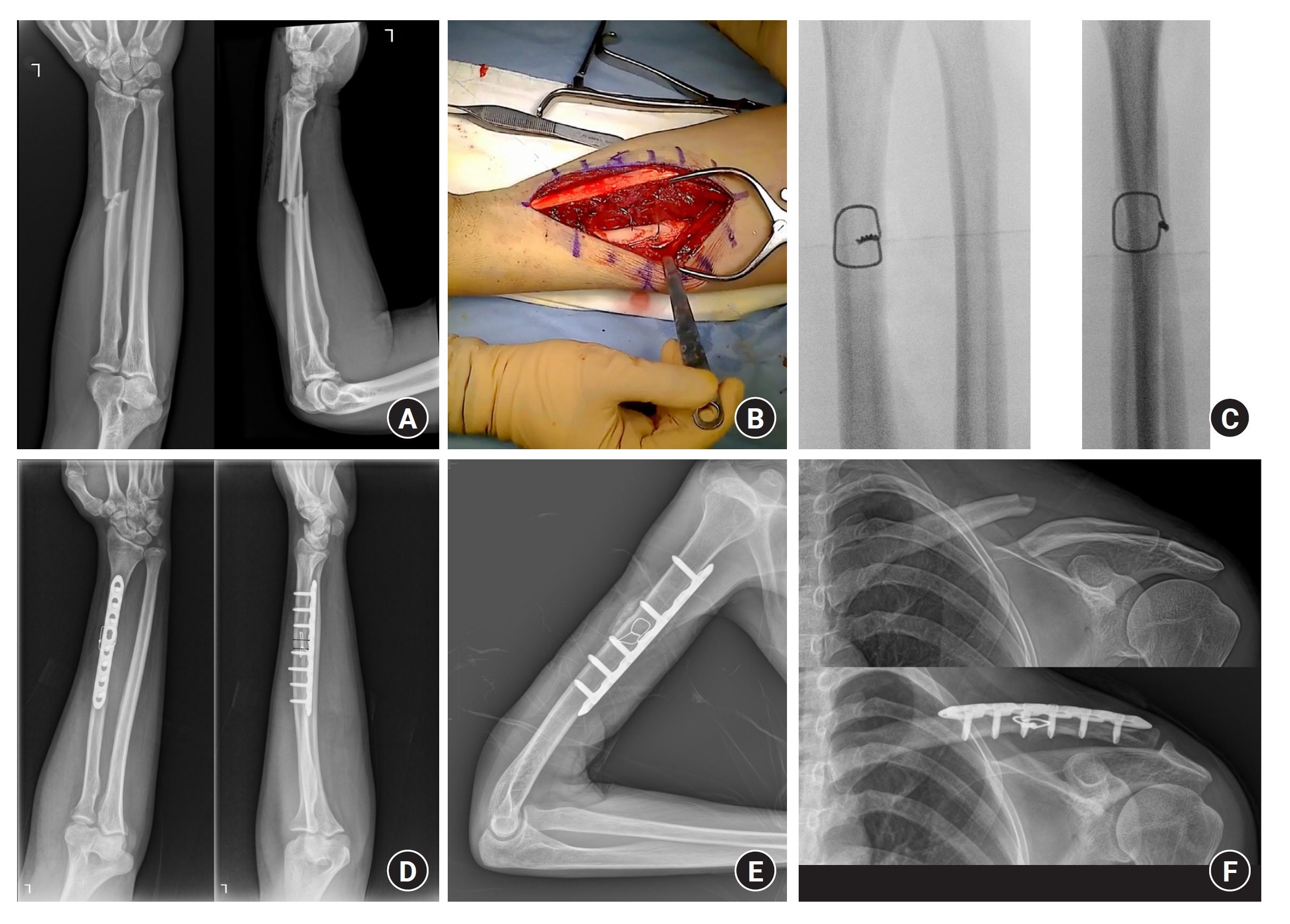Arch Hand Microsurg.
2024 Mar;29(1):34-39. 10.12790/ahm.23.0039.
Transosseous wiring method for simple transverse shaft fracture of the upper extremity
- Affiliations
-
- 1Department of Orthopaedic Surgery, Nowon Eulji Medical Center, Eulji University, Seoul, Korea
- 2Department of Orthopaedic Surgery, Dong-A University College of Medicine, Busan, Korea
- 3Department of Orthopaedic Surgery, Seoul National University College of Medicine, Seoul, Korea
- KMID: 2553169
- DOI: http://doi.org/10.12790/ahm.23.0039
Abstract
- Purpose
A diaphyseal simple transverse fracture (DSTF) of the upper extremity (UE) requires direct anatomical reduction and absolute stability. No standard efficient method exists for reducing and maintaining a DSTF, despite its importance. Here, we introduce our transosseous wiring (TOW) method for UE-DSTFs.
Methods
To maintain reduction, the UE-DSTF was first fixed with TOW before definitive fixation with a locking plate across the fracture. We retrospectively reviewed 15 patients with at least 1 year of postoperative follow-up treatment from 2019 to 2021.
Results
All patients had achieved anatomical reduction and bone union at the final follow-up. Three patients had hardware removed because of irritation caused by the plate and screws. However, none of those three patients complained of irritation from the wire. One patient experienced refracture at the same site after hardware removal after a fall. The same technique was used in this case, and the bone union was observed 6 months after surgery.
Conclusion
TOW is a simple straightforward method that can be applied without special instruments. It could be an efficient method for interfragmentary compression and attachment of a locking plate without the burden of maintaining the reduction of UE-DSTFs.
Keyword
Figure
Reference
-
References
1. Märdian S, Schmölz W, Schaser KD, Duda GN, Heyland M. Interfragmentary lag screw fixation in locking plate constructs increases stiffness in simple fracture patterns. Clin Biomech (Bristol, Avon). 2015; 30:814–9.
Article2. Märdian S, Schmölz W, Schaser KD, Duda GN, Heyland M. Locking plate constructs benefit from interfragmentary lag screw fixation with decreased shear movements and more predictable fracture gap motion in simple fracture patterns. Clin Biomech (Bristol, Avon). 2019; 70:89–96.
Article3. Horn C, Döbele S, Vester H, Schäffler A, Lucke M, Stöckle U. Combination of interfragmentary screws and locking plates in distal meta-diaphyseal fractures of the tibia: a retrospective, single-centre pilot study. Injury. 2011; 42:1031–7.
Article4. Leung F, Chow SP. Locking compression plate in the treatment of forearm fractures: a prospective study. J Orthop Surg (Hong Kong). 2006; 14:291–4.
Article5. Plecko M, Lagerpusch N, Pegel B, Andermatt D, Frigg R, Koch R, et al. The influence of different osteosynthesis configurations with locking compression plates (LCP) on stability and fracture healing after an oblique 45° angle osteotomy. Injury. 2012; 43:1041–51.
Article6. Gardner TN, Hardy J, Evans M, Kenwright J. Temporal changes in dynamic inter fragmentary motion and callus formation in fractures. J Biomech. 1997; 30:315–21.
Article7. Aro HT, Chao EY. Bone-healing patterns affected by loading, fracture fragment stability, fracture type, and fracture site compression. Clin Orthop Relat Res. 1993; (293):8–17.
Article8. Eastaugh-Waring SJ, Joslin CC, Hardy JR, Cunningham JL. Quantification of fracture healing from radiographs using the maximum callus index. Clin Orthop Relat Res. 2009; 467:1986–91.
Article9. Heim D, Luria S, Mosheiff R, Weil Y. Transverse simple fracture of the ulna [Internet]. In: Colton OL, editor. AO Surgery Reference. Davos: AO Foundation; 2013 [cited 2023 Feb 6]. Available from: https://surgeryreference.aofoundation.org/orthopedic-trauma/adult-trauma/forearm-shaft/transverse-simple-fracture-of-the-ulna/orif-compression-plating#reduction.10. Court-Brwon CM, McQueen MM, McKee M, Tornetta P III. Techniques and instruments for fracture reduction. In : Rockwood CA, editor. Rockwood and Green's fractures in adults. 8th ed. Philadelphia: Wolters Kluwer Health;2014. p. 206–14.11. Han SH, Cha YS, Song WT. Arthrodesis of distal interphalangeal joints in the hand with interosseous wiring and intramedullary K-wire fixation. Clin Orthop Surg. 2014; 6:401–4.
Article12. Githens T, Murphree J, Daneshfar C, MacKay B. Interosseus wiring of distal radius fractures with volar comminution. Tech Orthop. 2019; 34:46–9.
Article13. Gingrass RP, Fehring B, Matloub H. Intraosseous wiring of complex hand fractures. Plast Reconstr Surg. 1980; 66:383–94.
Article14. Kim HJ, Lee HJ, Kim PT, Kyung HS, Oh JW, Lee SJ. Modified transosseous wiring technique for neglected fracture-dislocation of the proximal interphalangeal joint. Clin Orthop Surg. 2019; 11:220–5.
Article15. Renton TF, Wiesenfeld D. Mandibular fracture osteosynthesis: a comparison of three techniques. Br J Oral Maxillofac Surg. 1996; 34:166–73.
Article
- Full Text Links
- Actions
-
Cited
- CITED
-
- Close
- Share
- Similar articles
-
- Transosseous Tie Fixation Using Krackow Sutures and Bone Tunnels in a Comminuted Fracture of the Upper Pole of the Patella: A Case Report
- Operative Treatment of patellar Fractures
- Treatment of Patella Fracture Using Wiring Method
- Plate Designed for Wiring ( CHO Plate )
- Tension band wiring and Modified tension band wiring in the Operative Treatment of Patella Fracture



